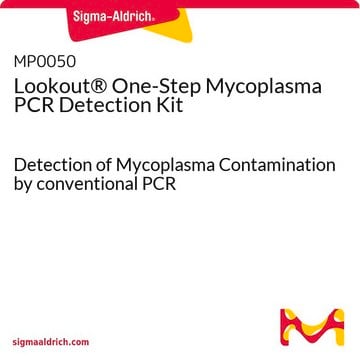MP0035
LookOut® Mycoplasma PCR Detection Kit
Optimized for use with JumpStart™ Taq DNA Polymerase, D9307.
Synonim(y):
PCR-based mycoplasma screening
About This Item
Polecane produkty
jakość
Not suitable for clinical diagnostic use. Will not detect clinically relevant species such as M. pneumoniae and U. urealyticum
opakowanie
pkg of 1 kit
metody
PCR: suitable
Zastosowanie
detection
microbiology
kompatybilność
Optimized for use with JumpStart™ Taq DNA Polymerase, D9307.
temp. przechowywania
2-8°C
Opis ogólny
The reaction tubes included with the kit are pre-coated with appropriate dNTPs, primers, and loading dye. Total assay time is greatly reduced compared to general protocols that require individual loading of reaction tubes.
Zastosowanie
Kompatybilność
Informacje prawne
produkt powiązany
Kod klasy składowania
10 - Combustible liquids
Temperatura zapłonu (°F)
Not applicable
Temperatura zapłonu (°C)
Not applicable
Certyfikaty analizy (CoA)
Poszukaj Certyfikaty analizy (CoA), wpisując numer partii/serii produktów. Numery serii i partii można znaleźć na etykiecie produktu po słowach „seria” lub „partia”.
Masz już ten produkt?
Dokumenty związane z niedawno zakupionymi produktami zostały zamieszczone w Bibliotece dokumentów.
Klienci oglądali również te produkty
Produkty
Wykryj skażenie mykoplazmą w hodowli komórkowej za pomocą testów PCR, barwienia DNA lub hodowli. Odkryj zestawy do zapobiegania, eliminacji i wykrywania mykoplazmy.
Detect mycoplasma contamination in cell culture through the PCR, DNA stain, or culture tests. Discover mycoplasma prevention, elimination, and detection kits.
Review the basics of using fetal bovine (or calf) serum for cell culture and how sourcing and regulations affect the price of sera for cell-based assays.
Overview on how to maintain proper cell culture laboratory safety including steps on performing lab risk assessments, surface disinfection, biohazard and waste removal. Free ECACC handbook download.
Protokoły
Mycoplasma contamination of cell cultures is a serious issue impacting cell model validity. PCR testing for mycoplasma is an inexpensive, sensitive, and specific method for detecting contamination.
Zanieczyszczenie hodowli komórkowych mykoplazmą jest poważnym problemem wpływającym na wiarygodność modeli komórkowych. Test PCR na obecność mykoplazmy jest niedrogą, czułą i specyficzną metodą wykrywania skażenia.
Nasz zespół naukowców ma doświadczenie we wszystkich obszarach badań, w tym w naukach przyrodniczych, materiałoznawstwie, syntezie chemicznej, chromatografii, analityce i wielu innych dziedzinach.
Skontaktuj się z zespołem ds. pomocy technicznej






